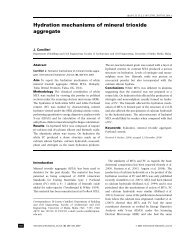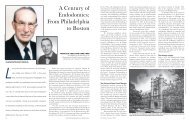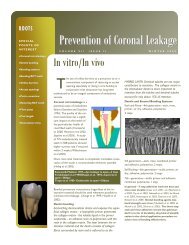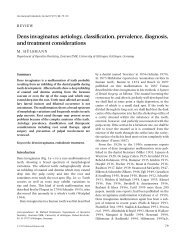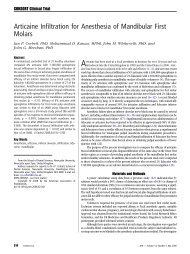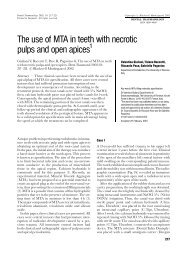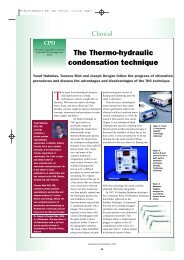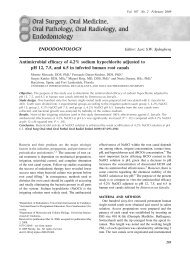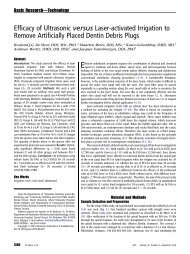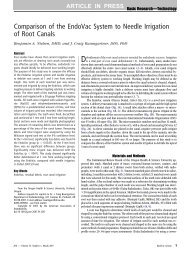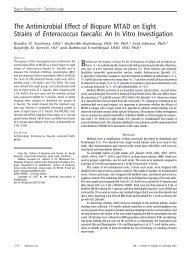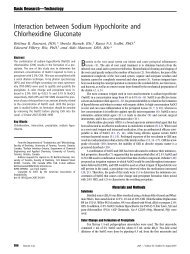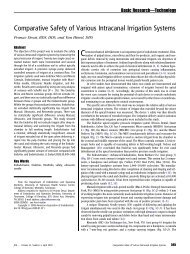Journal of Dental Research - The EndoExperience
Journal of Dental Research - The EndoExperience
Journal of Dental Research - The EndoExperience
Create successful ePaper yourself
Turn your PDF publications into a flip-book with our unique Google optimized e-Paper software.
Vol1 54 1975<br />
the quality <strong>of</strong> the dentin bridge formed and<br />
underlined the risk <strong>of</strong> residual chronic<br />
pulpal inflammation. Zinc oxide eugenol<br />
cement seemed to provide more favorable<br />
pulp healing than calcium hydroxide, but<br />
no complete dentin bridge formed.76 Clinical77<br />
and experimental78 studies apparently<br />
substantiated the efficacy <strong>of</strong> Dycal as a direct<br />
pulp capping agent, whereas in pulp exposures<br />
<strong>of</strong> intact rat molars Hydrex produced<br />
chronic inflammation and pulp necrosis.79<br />
In pulpotomies, after sterile amputation<br />
<strong>of</strong> the coronal pulp and calcium hydroxide<br />
application on the pulp stumps, Schroder<br />
and Granath80 observed that in young human<br />
premolars after one month a calcific<br />
barrier was formed first by an irregular bonelike<br />
substance while the last one resembled<br />
dentin. In primary teeth, after pulpotomy,<br />
dressings <strong>of</strong> calcium hydroxide or Formalincontaining<br />
compounds have been recommended.<br />
<strong>The</strong>y were evaluated in primary<br />
and young permanent teeth <strong>of</strong> rhesus monkeys.81<br />
It seemed that the Formocresol<br />
therapy gave results superior to the hydroxide<br />
pulp therapy. In incompletely formed<br />
pulpless teeth, the relationship <strong>of</strong> calcium<br />
hydroxide paste to continued root formation<br />
and absence <strong>of</strong> inflammatory response<br />
in the periapical tissues has been demonstrated<br />
in dogs.82<br />
Indirect pulp capping with antibiotics<br />
does not seem to be adequate: dentinal application<br />
<strong>of</strong> penicillin47 or association with<br />
camphorated paramonochlorphenol63 produced<br />
pulpal inflammation. Studies with<br />
conventional and germfree rats demonstrated<br />
that the presence <strong>of</strong> bacteria is a<br />
significant factor in prohibiting healing <strong>of</strong><br />
pulp exposures.83 <strong>The</strong> association <strong>of</strong> calcium<br />
hydroxide with vancomycinf as direct<br />
pulp capping agents was more successful<br />
than calcium hydroxide alone.84 However,<br />
the single use <strong>of</strong> sodium cephalothin"<br />
proved to be too irritating for vital pulp<br />
therapy.78<br />
Controversial results also have been obtained<br />
with corticosteroids used alone or associated<br />
with antibiotics. When corticosteroids<br />
were used for indirect pulp capping,<br />
suppression or reduction <strong>of</strong> pulpal inflammation<br />
without alteration <strong>of</strong> dentinogenesis<br />
f Vancocin, Eli Lilly Co., Indianapolis, Ind.<br />
g Keflin, Eli Lilly Co., Indianapolis, Ind.<br />
Downloaded from<br />
http://jdr.sagepub.com by on January 29, 2010<br />
DENTIN AND PULP REACTIONS B181<br />
was observed by most authors85-87; in direct<br />
pulp capping, persistent inflammation with<br />
increased dentinogenesis63 or the absence <strong>of</strong><br />
dentin formation87'88 was noted. In germfree<br />
animals,83 it is interesting to note that<br />
application <strong>of</strong> corticosteroids is neither helpful<br />
nor harmful to exposed pulp -healing.<br />
Most authors observed a persistent chronic<br />
inflammation <strong>of</strong> the pulp with a corticosteroid-antibiotic<br />
preparationh in direct pulp<br />
capping.63,87<br />
Preliminary results seemed to indicate that<br />
lyophylized89 or demineralized90 dentin<br />
could be better direct capping agents than<br />
calcium hydroxide, antibiotics, or corticosteroids.<br />
Base Cements, Liners, and Varnishes<br />
A combination <strong>of</strong> ZOE is still widely used<br />
for temporary fillings and protective bases<br />
under permanent fillings. It has been stated<br />
that ZOE, like zinc phosphate cement, can<br />
be irritating in deep cavities; nevertheless,<br />
most testing experiments <strong>of</strong> materials use<br />
ZOE as a control material.<br />
Since ZOE has low compressive strength,<br />
different additives have been proposed to<br />
reinforce the original formulation. IRMi<br />
(a resin-reinforced ZOE), EBA,j Kalsogen,k<br />
and Cazil seemed to be biologically acceptable<br />
but also slightly more irritative than<br />
ZOE.41 ,91<br />
It was thought that oxyphosphate cements<br />
and copper cements were damaging to the<br />
pulp. According to Langeland,37 this is<br />
seemingly true for copper cements, but not<br />
for oxyphosphate cements. It seemed that<br />
the reactions observed were due to overdrying<br />
<strong>of</strong> the cavity. Whereas Plant and Tyas92<br />
and Eriksen93 observed mild reaction with<br />
Dropsin,m a modified zinc phosphate, Holz<br />
and Baume4' consider this cement as improper<br />
for pulpal protection.<br />
<strong>The</strong> polycarboxylate cement system, first<br />
developed by Smith,94 consists <strong>of</strong> a modified<br />
zinc oxide powder and an aqueous solution<br />
<strong>of</strong> polyacrylic acid. Zinc phosphate and<br />
polycarboxylate cements appear to have<br />
similar properties especially in setting time<br />
h Ledermix, Lederle Arzneimittel, Cyanamid Gmbh,<br />
Munchen-Pasing, West Germany.<br />
I L. D. Caulk Co., Milford, Del.<br />
J Opotow <strong>Dental</strong> Mfg. Co., Brooklyn, NY.<br />
k De Trey, Zurich, Switzerland.<br />
National Bureau <strong>of</strong> Standards, Washington, DC.<br />
m Svedia, Enkoping, Sweden.



